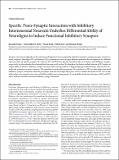Specific Trans-Synaptic Interaction with Inhibitory Interneuronal Neurexin Underlies Differential Ability of Neuroligins to Induce Functional Inhibitory Synapses
Author(s)
Futai, Kensuke; Doty, Christopher D.; Baek, Brian; Ryu, Jubin; Sheng, Morgan Hwa-Tze
DownloadFutai-2013-Specific Trans-Synap.pdf (3.163Mb)
PUBLISHER_POLICY
Publisher Policy
Article is made available in accordance with the publisher's policy and may be subject to US copyright law. Please refer to the publisher's site for terms of use.
Terms of use
Metadata
Show full item recordAbstract
Synaptic transmission depends on the matching and alignment of presynaptically released transmitters and postsynaptic neurotransmitter receptors. Neuroligin (NL) and Neurexin (Nrxn) proteins are trans-synaptic adhesion molecules that are important in validation and maturation of specific synapses. NL isoforms NL1 and NL2 have specific functional roles in excitatory and inhibitory synapses, respectively, but the molecular basis behind this distinction is still unclear. We show here that the extracellular domain of NL2 confers its unique ability to enhance inhibitory synaptic function when overexpressed in rat hippocampal pyramidal neurons, whereas NL1 normally only promotes excitatory synapses. This specificity is conferred by presynaptic Nrxn isoforms, as NL1 can also induce functional inhibitory synapse connections when the presynaptic interneurons ectopically express an Nrxn isoform that binds to NL1. Our results indicate that trans-synaptic interaction with differentially expressed presynaptic Nrxns underlies the distinct functions of NL1 and NL2, and is sufficient to induce functional inhibitory synapse formation.
Date issued
2013-02Department
Picower Institute for Learning and MemoryJournal
Journal of Neuroscience
Publisher
Society for Neuroscience
Citation
Futai, K., C. D. Doty, B. Baek, J. Ryu, and M. Sheng. “Specific Trans-Synaptic Interaction with Inhibitory Interneuronal Neurexin Underlies Differential Ability of Neuroligins to Induce Functional Inhibitory Synapses.” Journal of Neuroscience 33, no. 8 (February 20, 2013): 3612-3623.
Version: Final published version
ISSN
0270-6474
1529-2401